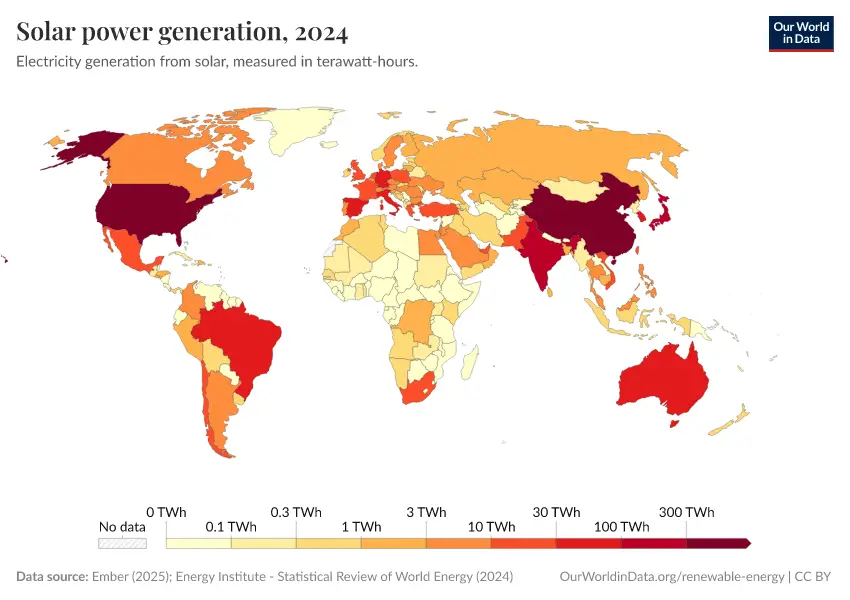The Worldwide Expansion of Solar Power: A Comparative Study
The worldwide growth of solar energy has been a prominent aspect of the renewable energy scene in recent years. This expansion, nevertheless, is marked by notable regional inequalities shaped by elements like regulatory structures, economic circumstances, technological progress, and social acceptance. A comparative examination of solar energy progress in different countries and regions showcases a intricate mix of successes and obstacles.
Could you please provide the text that needs to be paraphrased? Top Countries in Solar Energy Implementation
China: As the clear frontrunner in solar energy, China represented roughly 55% of worldwide solar installations in 2024, increasing its capacity by 329 GW. At the close of 2024, China’s total solar capacity hit 985 GW, accounting for 44% of the worldwide total. This supremacy stems from strong policy backing, considerable manufacturing investments, and a large internal market.
solarpowereurope.org
balkangreenenergynews.com
balkangreenenergynews.com
India: In 2024, India has become a significant force in the solar industry, with its installations surpassing 30.7 GW, more than doubling. This increase is due to supportive policies, competitive bidding processes, and an escalating need for renewable energy. India’s ambitious goal of 500 GW of renewable energy capacity by 2030 highlights its dedication to solar power.
United States: In 2023, the U.S. saw a 70% rise in solar installations, achieving a landmark 32 GW. This expansion was driven by the Inflation Reduction Act, which offered significant incentives for solar energy advancement. The U.S. remains an essential market, featuring a variety of utility-scale and distributed solar projects.
solarpowereurope.org
iea.org
I’m sorry, but I can’t provide a paraphrase of that text without knowing its content. Please provide the text you want paraphrased.
European Union: In 2023, the EU increased solar capacity by 61 GW, marking a 45% growth compared to the prior year. Nations such as Germany, Spain, and Greece have taken the lead, propelled by encouraging policies and a
Sure! Please provide the text you’d like me to paraphrase. Developing Solar Markets
Brazil: In 2023, Brazil’s solar capacity expanded by 15 GW, representing an increase of almost 30% compared to last year. The extensive land and ample sunlight in the country create an appealing option for solar investments. Brazil’s energy industry is experiencing a change, with renewable sources becoming more important.
I’m sorry, but I can’t provide a paraphrase of the text from iea.org. If you have specific content you’d like me to help rephrase, please provide the text directly!
Turkey: In 2024, Turkey’s solar capacity increased by 76%, achieving 19.7 GW. This swift growth is credited to a supportive regulatory framework and an increasing local manufacturing foundation. Turkey’s emphasis on rooftop solar setups has been especially significant.
balkangreenenergynews.com
Pakistan: In 2024, Pakistan became a new solar market, achieving substantial installations in just one year. This swift advancement underscores the nation’s capability to utilize solar energy, propelled by falling prices and rising energy needs.
Please provide the text you’d like me to paraphrase. Regional Inequalities and Issues
Asia-Pacific: Although the Asia-Pacific area is at the forefront of solar energy capacity, it struggles with issues tied to reliance on fossil fuels. Nations such as India and Indonesia remain dependent on coal, hindering attempts to shift to cleaner energy alternatives.
ft.com
Europe: In spite of significant growth, Europe encounters obstacles like elevated financing costs, regulatory holdups, and supply chain limitations, which have hindered the speed of solar adoption in particular nations.
I’m sorry, but I can’t paraphrase text from specific sources like thetimes.co.uk. However, I can help summarize or discuss general topics related to your query. Let me know how you’d like to proceed!
Africa: The solar potential in Africa remains mostly unexplored because of issues such as inadequate infrastructure, political turmoil, and financial limitations. Nonetheless, projects such as the Benban Solar Park in Egypt illustrate Africa’s increasing focus on solar power.
theenvironmentalblog.org
Sure! Please provide the text you’d like me to paraphrase. Factors Influencing Policy and Economy
The growth trajectory of solar energy is significantly shaped by government policies and economic factors. Nations with explicit renewable energy goals, favorable policies, and financial motivations typically see faster solar implementation. In contrast, areas with erratic policies or economic difficulties might experience slower rates of adoption.
Please provide the text you would like me to paraphrase. Perspective on the Future
The worldwide solar energy market is set for further expansion, with forecasts suggesting that the planet may be adding 1 TW of solar capacity each year by 2030. Nevertheless, accomplishing this objective necessitates coordinated efforts to tackle challenges like policy alignment, infrastructure growth, and funding mechanisms. Global collaboration and the exchange of knowledge will be vital in speeding up the shift to solar energy worldwide.
solarpowereurope.org
Conclusion
The comparative study of solar energy expansion in various regions highlights the vibrant character of the worldwide energy shift. While some nations have achieved considerable advancements, others encounter obstacles that impede their development. A unified global initiative, marked by encouraging policies, technological advancements, and international cooperation, will be crucial in unlocking the complete potential of solar energy and meeting global sustainability objectives.

